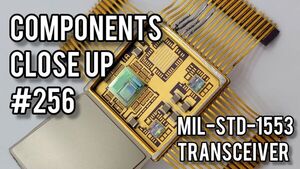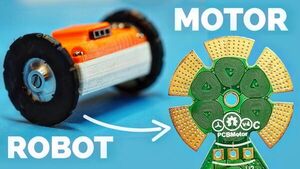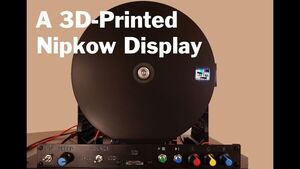2022-06-02 - Nº 370
Editorial
Esta é a Newsletter Nº 370 que se apresenta com o mesmo formato que as anteriores. Se gostar da Newsletter partilhe-a!
Todas as Newsletters encontram-se indexadas no link.
Esta Newsletter tem os seguintes tópicos:
Faz hoje anos que nascia, em 1787, o químico sueco Nils Gabriel Sefström. Ele descobriu o elemento vanádio. Ele examinou minério de ferro depois de um gerente de mina ter apontado um teste interessante. Foi-lhe dito, se um lote de minério fosse tratado com ácido clorídrico e aparecesse um pó preto, então o ferro seria quebradiço. Através de um estudo mais aprofundado, descobriu que isto nem sempre era verdade, pois por vezes aparecia um pó preto de ferro que não era quebradiço (1831). Pela análise do pó, embora semelhante ao crómio ou ao urânio, ele determinou que se tratava de um novo elemento. Sefström deu-lhe o nome de vanádio, em homenagem a uma deusa nórdica. Uma descoberta anterior, mas provisória, tinha sido feita em 1801 por Andrés Manuel del Río, um mineralogista espanhol que não tinha confiança na sua descoberta de um novo elemento a que deu o nome de eritrónio. Este foi mais tarde descoberto como sendo o mesmo que o vanádio.
Faz também hoje anos que nascia, em 1881, o Engenheiro electrotécnico inglês H. J. Round. Ele foi responsável por inúmeras invenções que contribuíram para o desenvolvimento das comunicações via rádio. Entrou para a Companhia Marconi em 1902, e pelo seu trabalho mais antigo concebeu os elementos de equipamento de procura de direcção. Tornou-se Chefe da Marconi Research em 1921. Foi um inventor prolífico. Entre outras invenções, concebeu o Straight Eight Gramophone Recording System, um sistema de discurso público de grande audiência que foi utilizado para transmitir o discurso do Rei Jorge nas Exposições de Wembley. Um sistema de imagem falante que ele inventou foi utilizado para gravar som para filmar durante o boom do cinema dos anos 30. No total, ele produziu 117 patentes. A última foi "Pressure Wave Transmission Arrangements" (1964), aos 83 anos de idade.
Por fim, faz hoje anos que nascia, em 1903, o físico americano Robert Morris Page. Ele inventou a tecnologia do radar de pulso enquanto trabalhava no Laboratório de Investigação Naval dos Estados Unidos. Do trabalho pioneiro com os primeiros líderes de rádio, o Dr. Page concebeu e desenvolveu circuitos e componentes nos anos 30 para os primeiros sistemas de radar de pulso que utilizavam pequenas explosões de radiação electromagnética para detectar e localizar objectos distantes. Durante a II Guerra Mundial, esta invenção foi vital para os Aliados para a detecção de aviões, navios e outros alvos inimigos. Após a guerra, Page continuou a investigação sobre aplicações em tempo de paz de radar, rádio de bordo e outros campos da electrónica. Detinha sessenta e cinco patentes para inovações nestes campos, agora aplicadas na navegação, previsão do tempo, astronomia, automatização e campos técnicos relacionados.
Em 1954, o primeiro teste de um avião VTOL tem lugar quando um Convair XFY-1 Pogo demonstrou uma descolagem e aterragem verticais. Era conhecido como "Tail Sitter", mas como protótipo para testar o conceito, a sua glória queimou, e desvaneceu-se numa questão de meses. O XFY-1 era um protótipo de um caça interceptor de defesa pontual destinado à Marinha. A única virtude era que não precisava de uma pista de aterragem, pois o XFY-1 foi construído para se sentar direito na sua cauda, e descolar a direito, usando enormes hélices contra-rotativas no seu nariz. Após a descolagem, um assentador de cauda mudou de voo vertical estilo helicóptero para avião, empurrando simplesmente da ascensão vertical para o voo horizontal convencional. Na aterragem, o processo foi invertido para aterrar na sua cauda. Era demasiado difícil de voar.
Nesta semana que passou ficámos a saber que a NASA está a preparar o helicóptero Ingenuity que se encontra em Marte, para conseguir-se manter operacional durante o "inverno" que está a começar neste planeta. Dados da telemetria demonstram que a perda de comunicação com o equipamento foi devido a falta de energia na bateria, decorrente das noites maiores. Desafios como estes são de esperar: Após centenas de sols e dezenas de voos para além dos cinco voos inicialmente previstos, o helicóptero movido a energia solar encontra-se em terreno inexplorado. Estamos agora a operar muito para além dos nossos limites originais de concepção. Historicamente, Marte é um grande desafio para as naves espaciais (particularmente as movidas a energia solar). Cada sol pode ser o último da Ingenuidade.
Na Newsletter desta semana apresentamos diversas noticias, artigos científicos, projetos de maker e alguns vídeos interessantes.
 João Alves ([email protected])
João Alves ([email protected])
O conteúdo da Newsletter encontra-se sob a licença  Creative Commons Attribution-NonCommercial-ShareAlike 4.0 International License.
Creative Commons Attribution-NonCommercial-ShareAlike 4.0 International License.
Novidades da Semana

Ingenuity Adapts for Mars Winter Operations
"As detailed in our last blog post, for the first time in our yearlong extended mission we had a loss of communications with Ingenuity from the downlink of May 3 (Sol 427) and May 4 (Sol 428). After a week of anomaly investigation, two sols dedicated to data collection, and the heroic efforts of the Perseverance and Ingenuity operations teams, I am very happy to report that we have reestablished reliable communications with Ingenuity. Based on all available telemetry, the helicopter appears healthy, and we have resumed a modified form of operations. Assuming winter recommissioning activities complete nominally, Ingenuity’s 29th flight may occur in the next few sols. Telemetry from Ingenuity confirmed that the loss of communications was due to insufficient battery state-of-charge (SOC) going into the night, which resulted in a reset of our mission clock. This daily SOC deficit is likely to persist for the duration of Martian winter (until September/October)." [...]
Outras Notícias

NASA’s Perseverance Studies the Wild Winds of Jezero Crater
"The rover’s weather sensors witnessed daily whirlwinds and more while studying the Red Planet. During its first couple hundred days in Jezero Crater, NASA’s Perseverance Mars rover saw some of the most intense dust activity ever witnessed by a mission sent to the Red Planet’s surface. Not only did the rover detect hundreds of dust-bearing whirlwinds called dust devils, Perseverance captured the first video ever recorded of wind gusts lifting a massive Martian dust cloud. A paper recently published in Science Advances chronicles the trove of weather phenomena observed in the first 216 Martian days, or sols. The new findings enable scientists to better understand dust processes on Mars and contribute to a body of knowledge that could one day help them predict the dust storms that Mars is famous for – and that pose a threat to future robotic and human explorers. “Every time we land in a new place on Mars, it’s an opportunity to better understand the planet’s weather,” said the paper’s lead author, Claire Newman of Aeolis Research, a research company focused on planetary atmospheres." [...]
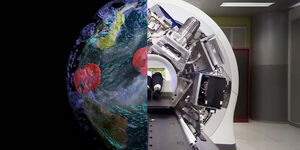
Solving the World’s Biggest Challenges, Together
"More problems, more possibilities: NVIDIA technologies accelerate innovation in every aspect of human endeavor. Gamers know NVIDIA powers great gaming experiences. Researchers know NVIDIA speeds world-changing breakthroughs. Businesses know us for the AI engines transforming their industries. And NVIDIA employees know the company as one of the best places to work on the planet. More people than ever have a piece of NVIDIA." [...]

Toshiba Announces DT02 7200RPM 2TB Hard Disk Drive
"Toshiba Electronic Devices & Storage Corporation (Toshiba) announces the DT02 7200RPM 2TB HDD, designed for desktop, PC computing, gaming and storage applications where performance and reliability are critical. The new DT02 7200RPM 2TB HDD delivers higher performance than Toshiba’s predecessor and leverages Shingled Magnetic Recording (SMR) Technology. The DT02 7200RPM 2TB HDD has a SATA 6 Gbit/s interface and a 2TB[1] capacity. The DT02 7200RPM 2TB HDD has a 19% increase in data transfer speed compared to Toshiba’s current "DT02 series," achieving a maximum of 210 MiB/s [2], equipped with a 256MB buffer, making it suitable for desktop, PC computing, gaming and storage applications. The DT02 7200RPM 2TB HDD is available from this month. " [...]
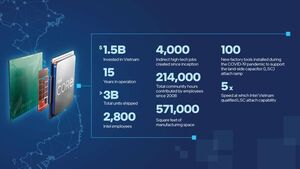
Intel Taps Factory Network to Overcome Substrate Shortages
"Intel today recognized the contributions of its Vietnam site to alleviating constraints in the global semiconductor supply chain. Thanks to an innovative approach to processing substrates in its assembly and test factory, Intel delivered millions of additional units of chip production over the past year – meeting customer demand while the industry struggled to weather a shortage of this critical component. Since the beginning of the global pandemic, surging demand for computing has placed the semiconductor industry at the epicenter of unprecedented supply chain disruptions. This has created a shortage of key chipmaking components, including a foundational piece of nearly every advanced processor in the world: the Ajinomoto build-up film (ABF) substrate. Before a computer chip leaves the factory, it is mounted between a substrate and a heat spreader to form a completed processor. This “package” protects the chip and forms electrical connections between the processor and the circuit board in a computer." [...]

Lattice Extends its Control FPGA Leadership with Introduction of MachXO5-NX Family
"Lattice Semiconductor (NASDAQ: LSCC), the low power programmable leader, today extended its long-standing leadership in control FPGAs with the introduction of Lattice MachXO5™-NX family, the fifth device built on the award-winning Lattice Nexus™ platform. MachXO5-NX FPGAs enable the latest generation of secure control through increased logic and memory resources, robust 3.3 V I/O support, and a differentiated security feature set. Designed to enhance system monitoring and control in Server Compute, Communications, Industrial, and Automotive markets, MachXO5-NX FPGAs offer class-leading power efficiency and reliability. “Fast-growing demands for secure system monitoring and reliability require additional control system capabilities. Our customers are looking for innovative solutions to meet these demands while increasing design efficiency and simplifying system integration,” said Gordon Hands, Senior Director of Product Marketing, Lattice Semiconductor. “To help our customers to get to market fast, MachXO5-NX FPGAs provide the right combination of advanced features, security, power efficiency, and reliability to meet their evolving needs.” Lattice MachXO5-NX FPGAs deliver: - Increased logic and memory resources - MachXO5-NX FPGAs combine a 25k logic cell capacity FPGA fabric with 1.9 Mb of embedded memory reducing the design footprint by minimizing the need for external memory." [...]

Microchip Simplifies Automotive Designs with ISO 26262-Compliant, AUTOSAR-Ready Devices and Ecosystem
"New dsPIC33C DSCs add support for AUTOSAR, OS, MCAL drivers and functional safety, enabling robust and secure automotive solutions OEMs are experiencing increasing application complexity and the need for AUTOSAR, ISO 26262 functional safety-compliant and secure solutions as the market for electric and autonomous vehicles grows. For automotive developers looking to design scalable applications for future technology while also meeting the latest automotive requirements, Microchip Technology Inc. (Nasdaq: MCHP) today announces a comprehensive ecosystem around AUTOSAR-ready dsPIC33C Digital Signal Controllers (DSCs) to enable accelerated development and a high level of system optimization while reducing total system cost. Microchip is expanding its broad portfolio of dsPIC33C DSCs to cover the large memory segment with the new ISO 26262-compliant dsPIC33CK1024MP7xx family. This new family of dsPIC33C DSCs with 1 MB Flash enables applications running automotive software like AUTOSAR, OS, MCAL drivers, ISO 26262 functional safety diagnostics and security libraries. The family of dsPIC33 DSCs also includes a high-performance Central Processing Unit (CPU) with deterministic response and specialized peripherals for general automotive, advanced sensing and control, digital power and motor control applications. “The AUTOSAR-ready dsPIC33C DSCs enable designers to achieve a high level of system optimization by implementing AUTOSAR-based applications, functional safety goals and security use cases in a single microcontroller (MCU) while meeting robust automotive application requirements,” said Joe Thomsen, vice president of the MCU16 business unit at Microchip Technology." [...]

New processors make edge AI more accessible while cutting power consumption in half
"Engineers can meet form-factor requirements and deploy smart designs anywhere with power-efficient processors. Expanding on its history of delivering highly integrated processors, Texas Instruments (TI) (Nasdaq: TXN) today introduced new Sitara™ AM62 processors that help expand edge artificial intelligence (AI) processing into next-generation applications. The low-power design of the new processors enables support for dual-screen displays and small-size human-machine interface (HMI) applications. For more information, see ti.com/product/AM625. TI will showcase the new AM62 processors and demonstrate system-level solutions for edge AI and electric vehicle charging HMI applications in booth No. 215 at embedded world in Nuremburg, Germany, June 21-23, 2022." [...]

Renesas Unveils Industry’s First I3C Intelligent Switch Family for Next Generation Server, Storage and Communications Systems
"Innovative Devices Enable Control Bus Scaling in Chassis- and Rack-Based Systems While Simplifying Overall Design. Renesas Electronics Corporation (TSE:6723), a premier supplier of advanced semiconductor solutions, today unveiled the industry’s first I3C intelligent switch devices targeting next generation server motherboards and other infrastructure equipment. The new chips vastly enhance scalability and reliability while reducing the complexity of high-performance system designs. They enable I3C control plane networks with multiple initiator controllers, such as CPU and Baseboard Management Controllers (BMC), to support targets across a large physical network running at full speed by improving signal integrity and reducing capacitive loading. They also support heterogeneous designs by providing IO level shifting and protocol translation for mixed I2C/SMBus and I3C networks. The MIPI I3C® bus is a scalable control bus interface for connecting peripherals to processor or other management controllers." [...]
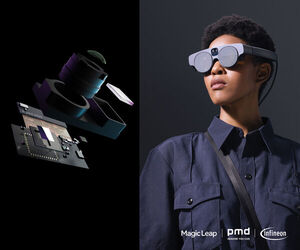
Infineon and pmdtechnologies develop 3D depth-sensing technology for Magic Leap 2 – enabling advanced cutting-edge industrial and medical applications
"Augmented reality (AR) applications are about to fundamentally change the way we live and work. Later this year, AR pioneer Magic Leap is expected to introduce its newest AR device, the Magic Leap 2. Designed specifically for enterprise use, Magic Leap 2 will be among the most immersive enterprise AR headsets in the market. With industry-leading optics and powerful computing in an ergonomic design, Magic Leap 2 will enable operators to work more efficiently, help companies optimize complex processes, and allow staff to seamlessly collaborate. One of the key features of Magic Leap 2 is the 3D indirect-Time-of-Flight (iToF) depth sensing technology that was co-developed by Infineon Technologies AG (FSE: IFX / OTCQX: IFNNY) and pmdtechnologies ag (pmd). Magic Leap 2 demonstrates the potential of the REAL3™ 3D Image Sensor." [...]

Renesas Introduces Complex Device Driver Software to Ease Development of Battery Management Systems for Electric Vehicles
"New Software Complements Renesas Leading Li-Ion Battery Manager IC to Enable ASIL D-Compliant Designs. Renesas Electronics Corporation (TSE:6723), a premier supplier of advanced semiconductor solutions, today introduced an AUTOSAR-compliant complex device driver (CDD) software module for designers of automotive battery management systems (BMS) in electric vehicles (EVs). The new software pairs with Renesas’ industry-leading ISL78714 Li-Ion battery management IC to speed design and optimize performance of next-generation systems. The CDD software is designed to work with Renesas’ Winning Combination BMS reference design hardware kit, which includes the ISL78714 IC and the RH850/P1M MCU. The CDD includes configuration and integration of required microcontroller abstraction layer (MCAL) modules provided by Renesas for the RH850 MCU. It provides an entire low-level software solution for collecting battery cell voltage and temperature measurements and controlling cell balancing functions of the ISL78714." [...]
Ciência e Tecnologia
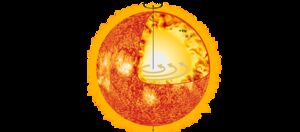
The Sun is spinning round again
"An international team led by astronomers from the UNIGE has succeeded in developing a model to solve part of the «solar problem». All was amiss with the Sun! In the early 2000s, a new set of data brought down the chemical abundances at the surface of the Sun, contradicting the values predicted by the standard models used by astrophysicists. Often challenged, these new abundances made it through several new analyses. As they seemed to prove correct, it was thus up to the solar models to adapt, especially since they serve as a reference for the study of stars in general. A team of astronomers from the University of Geneva, Switzerland (UNIGE) in collaboration with the Université de Liège, has developed a new theoretical model that solves part of the problem: considering the Sun’s rotation, that varied through time, and the magnetic fields it generates, they have been able to explain the chemical structure of the Sun." [...]

Artificial intelligence for stable processes in industry
"Bottle jams on the conveyor belt or overheated machines – such interruptions to production cost a lot of time and money. ETH spin-off Cerrion detects and analyses problems in the process automatically and in real time. The example of a production facility for glass bottles shows how complex the process is and why the processes have to be perfectly coordinated: A production line transports thousands of bottles per minute. But suddenly, all goes wrong – the bottles jam. What happened? Currently, specialists are needed to monitor and analyse the processes to find out where and when errors occur in the process." [...]

How Electric Fish Were Able to Evolve Electric Organs
"Electric organs help electric fish, such as the electric eel, do all sorts of amazing things: They send and receive signals that are akin to bird songs, helping them to recognize other electric fish by species, sex and even individual. A new study in Science Advances explains how small genetic changes enabled electric fish to evolve electric organs. The finding might also help scientists pinpoint the genetic mutations behind some human diseases. Evolution took advantage of a quirk of fish genetics to develop electric organs. All fish have duplicate versions of the same gene that produces tiny muscle motors, called sodium channels. To evolve electric organs, electric fish turned off one duplicate of the sodium channel gene in muscles and turned it on in other cells." [...]
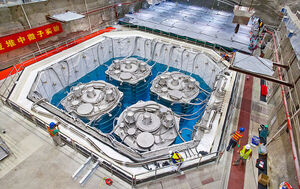
Physicists Announce First Results from Daya Bay's Final Dataset
"The Daya Bay Neutrino Experiment has produced the most precise measurement yet of theta13, a key parameter for understanding how neutrinos change their "flavor" Over nearly nine years, the Daya Bay Reactor Neutrino Experiment captured an unprecedented five and a half million interactions from subatomic particles called neutrinos. Now, the international team of physicists of the Daya Bay collaboration has reported the first result from the experiment’s full dataset—the most precise measurement yet of theta13, a key parameter for understanding how neutrinos change their “flavor.” The result, announced today at the Neutrino 2022 conference in Seoul, South Korea, will help physicists explore some of the biggest mysteries surrounding the nature of matter and the universe. Neutrinos are subatomic particles that are both famously elusive and tremendously abundant. They endlessly bombard every inch of Earth’s surface at nearly the speed of light, but rarely interact with matter. They can travel through a lightyear’s worth of lead without ever disturbing a single atom. One of the defining characteristics of these ghost-like particles is their ability to oscillate between three distinct “flavors”: muon neutrino, tau neutrino, and electron neutrino." [...]

Reliable knowledge about reliable AI
"German Academic Exchange Service funds artificial intelligence: A Konrad Zuse School is being established in Munich to provide top emerging talent with training in reliable AI. Although the AI boom seems to be unstoppable, it is currently being slowed down by a lack of emerging talent with suitable top-quality training. This is where the new Konrad Zuse School of Excellence in Reliable AI (relAI) comes in. The school is being set up by the Technical University of Munich (TUM) and LMU in conjunction with more than 20 partners from research and industry. It will build up a network from the worlds of science and enterprise so as to attract excellent emerging talent in the AI field from every corner of the globe. The project has been awarded funding by the German Academic Exchange Service (DAAD)." [...]

RIBB3D: Sustainable ribbed slabs with 3D printed formwork
"The project RIBB3D challenges the conventional design of floor slabs and allows to reinforced concrete structures in a material-efficient manner. By using robotic 3D printing to create customised plastic formwork for an uncommon two-way ribbed floor slab, the new approach uses 40 percent less concrete than a conventional solid slab, with no compromise on performance. Reinforced concrete floor slabs typically account for more than half of the carbon footprint of a multi-storey building. Most often, concrete floor slabs are built as solid slabs, not because of their structural efficiency, but rather because of the inexpensive planar formwork that can be used to cast them. The new RIBB3D solution succeeds in overcoming these limitations and uses digital fabrication processes to efficiently produce non-standard, optimised geometries. Design and fabrication informed by flow of forces RIBB3D combines structural engineering with digital fabrication tools to develop a workflow to design ribbed floor slabs based on the alignment of floor ribs with the internal force flow." [...]

Nanoparticles that mimic plant pigment to deliver better solar panels
"Researchers have taken inspiration from the world of plants to develop innovative and efficient nanoparticles that could be used to build the solar panels of the future. A team of engineers and biologists from the University of Surrey have synthesised nanoparticles that mimic what chlorophyll (the green pigment in most plants) does in nature – absorb light and convert it to usable energy with high efficiency. Past approaches have not been able to match what nature achieves; the efficiency of light-absorbing pigments drops when tightly packed. In the study, Surrey’s researchers detail how they developed a unique synthetic pigment that keeps its fluorescent intensity longer. Michael Spencer, lead author of the study and PhD student at the University of Surrey, said: “Mother Nature can teach us so much as we all think of ways to nurse our planet back to health. In this study, we looked at how light is absorbed, enhanced and utilised in biological systems, and we have incorporated those mechanisms into our own hybrid devices." [...]

Detecting new particles around black holes with gravitational waves
"Clouds of ultralight particles can form around rotating black holes. A team of physicists from the University of Amsterdam and Harvard University now show that these clouds would leave a characteristic imprint on the gravitational waves emitted by binary black holes. Black holes are generally thought to swallow all forms of matter and energy surrounding them. It has long been known, however, that they can also shed some of their mass through a process called superradiance. While this phenomenon is known to occur, it is only effective if new, so far unobserved particles with very low mass exist in nature, as predicted by several theories beyond the Standard Model of particle physics. Ionizing gravitational atoms When mass is extracted from a black hole via superradiance, it forms a large cloud around the black hole, creating a so-called gravitational atom." [...]
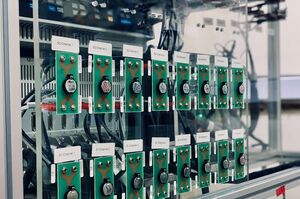
Novel strategy to make fast-charging solid-state batteries
"In a breakthrough, researchers at the Indian Institute of Science (IISc) and their collaborators have discovered how next-generation solid-state batteries fail and devised a novel strategy to make these batteries last longer and charge faster. Solid-state batteries are poised to replace the lithium-ion batteries found in almost every portable electronic device. But on repeated or excessive use, they develop thin filaments called ‘dendrites’ which can short-circuit the batteries and render them useless. In a new study published in Nature Materials, the researchers have identified the root cause of this dendrite formation – the appearance of microscopic voids in one of the electrodes early on. They also show that adding a thin layer of certain metals to the electrolyte surface significantly delays dendrite formation, extending the battery’s life and enabling it to be charged faster. Conventional lithium-ion batteries – the kind that you might find in your smartphone or laptop – contain a liquid electrolyte sandwiched between a positively charged electrode (cathode) made of a transition metal (such as iron and cobalt) oxide and a negatively charged electrode (anode) made of graphite." [...]
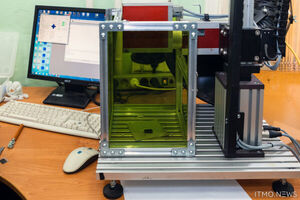
Flexible Electronics and Sensors: Researchers Develop Improved Method for Copper Micropattern Printing
"Scientists from ITMO University and the Institute of Chemistry of St. Petersburg State University have developed a more affordable and efficient method that makes printing copper micropatterns on a glass surface 100 times faster. The resulting micropatterns can be used in various devices, such as chemical sensors, flexible electronics, and anti-theft systems. Copper is a great conductor of electricity, which is why it is often used in electronics: for instance, in motherboards or printed circuit boards found in devices we use on a daily basis: computers, smartphones, washing machines, and others. In order for motherboards and printed circuit boards to conduct electricity, their surface is covered with several conductive micropatterns that are connected to each other and the board’s other elements. The patterns themselves can be created via several methods, such as lithography – a deep printing technique wherein the pattern is transferred from one coil to another and then electrically deposited. However, all of these methods aren’t ideal." [...]

Computer learns to write captions with feeling
"Teaching AI to capture the full spectrum of human emotions when annotating artwork. Giving artificial intelligence (AI) a more balanced perspective of artwork during training can reduce emotional bias in computer-generated captions. Despite incredible advances in AI, it remains a challenge to replicate the human emotional response to sensory stimuli such as sights and sounds. For example, in image captioning, an AI processes visual information and associated language to generate a natural-sounding description of the picture. But art often triggers unique feelings in the beholder that AI can’t experience, such as calm, joy, awe or fear. Researchers are turning to affective captioning to bridge the gap between human and machine emotional intelligence." [...]
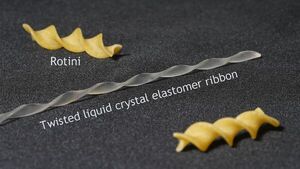
Twisted Soft Robots Navigate Mazes Without Human Or Computer Guidance
"Researchers from North Carolina State University and the University of Pennsylvania have developed soft robots that are capable of navigating complex environments, such as mazes, without input from humans or computer software. “These soft robots demonstrate a concept called ‘physical intelligence,’ meaning that structural design and smart materials are what allow the soft robot to navigate various situations, as opposed to computational intelligence,” says Jie Yin, corresponding author of a paper on the work and an associate professor of mechanical and aerospace engineering at NC State. The soft robots are made of liquid crystal elastomers in the shape of a twisted ribbon, resembling translucent rotini. When you place the ribbon on a surface that is at least 55 degrees Celsius (131 degrees Fahrenheit), which is hotter than the ambient air, the portion of the ribbon touching the surface contracts, while the portion of the ribbon exposed to the air does not. This induces a rolling motion in the ribbon. And the warmer the surface, the faster it rolls." [...]

Time crystals “impossible” but obey quantum physics
"Scientists have created the first ”time-crystal” two-body system in an experiment that seems to bend the laws of physics. It comes after the same team recently witnessed the first interaction of the new phase of matter. Time crystals were long believed to be impossible because they are made from atoms in never-ending motion. The discovery, published in Nature Communications, shows that not only can time crystals be created, but they have potential to be turned into useful devices. Time crystals are different from a standard crystal – like metals or rocks - which is composed of atoms arranged in a regularly repeating pattern in space. First theorised in 2012 by Nobel Laureate Frank Wilczek and identified in 2016, time crystals exhibit the bizarre property of being in constant, repeating motion in time despite no external input." [...]
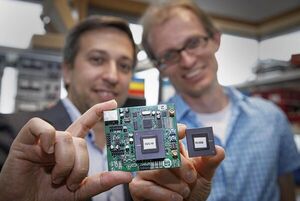
Building the processors of the future
"EU invests 11 million euros in TU/e-led project to build artificial intelligence at the edge. The corona pandemic and the war in Ukraine have shown that self-sufficiency in the production of semiconductors and computer chips is very much a matter of national security. It is one of the reasons why the European Union wants to become less dependent on processors manufactured outside Europe. Now that artificial intelligence is increasingly moving from the cloud and data centers to smart devices, we need new chips that are fast, secure, and energy-efficient. Convolve, a new European-funded and TU/e-led project, aims to make that a reality. Modern electronic devices become a lot more useful once connected to the internet." [...]

Quest for elusive monolayers just got a lot simpler
"Novel University of Rochester solution paves the way for cutting-edge photonics. One of the most tedious, daunting tasks for undergraduate assistants in university research labs involves looking hours on end through a microscope at samples of material, trying to find monolayers. These two-dimensional materials—less than 1/100,000th the width of a human hair—are highly sought for use in electronics, photonics, and optoelectronic devices because of their unique properties. “Research labs hire armies of undergraduates to do nothing but look for monolayers,” says Jaime Cardenas, an assistant professor of optics at the University of Rochester. “It’s very tedious, and if you get tired, you might miss some of the monolayers or you might start making misidentifications.” Even after all that work, the labs then must doublecheck the materials with expensive Raman spectroscopy or atomic force microscopy. Jesús Sánchez Juárez, a PhD student in the Cardenas Lab, has made life a whole lot easier for those undergraduates, their research labs, and companies that encounter similar difficulties in detecting monolayers." [...]
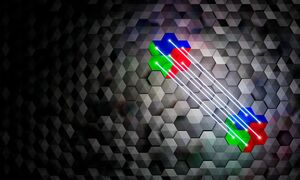
Error-Free Quantum Computing Gets Real
"For quantum computers to be useful in practice, errors must be detected and corrected. At the University of Innsbruck, Austria, a team of experimental physicists has now implemented a universal set of computational operations on fault-tolerant quantum bits for the first time, demonstrating how an algorithm can be programmed on a quantum computer so that errors do not spoil the result. In modern computers errors during processing and storage of information have become a rarity due to high-quality fabrication. However, for critical applications, where even single errors can have serious effects, error correction mechanisms based on redundancy of the processed data are still used. Quantum computers are inherently much more susceptible to disturbances and will thus probably always require error correction mechanisms, because otherwise errors will propagate uncontrolled in the system and information will be lost. Because the fundamental laws of quantum mechanics forbid copying quantum information, redundancy can be achieved by distributing logical quantum information into an entangled state of several physical systems, for example multiple individual atoms." [...]
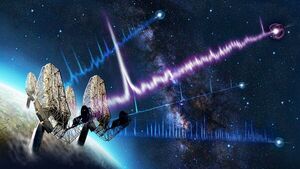
Strange neutron star spinning every 76 seconds discovered in stellar graveyard
"An international team of scientists have discovered a strange radio emitting neutron star, which rotates extremely slowly, completing one rotation every 76 seconds. The team, led by members of the ERC-funded MeerTRAP (More Transients and Pulsars) group at The University of Manchester say it is a unique discovery as it resides in the neutron star graveyard where they do not expect to see any radio emission at all. The discovery was made using the MeerKAT radio telescope in South Africa and published in the journal, Nature Astronomy. The source was initially found from a single flash, or pulse, by the MeerTRAP instrument whilst piggybacking on imaging observations being led by a different team, ThunderKAT. MeerTRAP and ThunderKAT then worked closely together to puzzle out its origin. Combining the data from the two teams, it was then possible to confirm the pulsations and get an accurate position for the source, enabling detailed and more sensitive follow up observations." [...]

MIT engineers boost signals from fluorescent sensors
"The advance allows the particles to be placed deeper within biological tissue, which could aid with cancer diagnosis or monitoring. Fluorescent sensors, which can be used to label and image a wide variety of molecules, offer a unique glimpse inside living cells. However, they typically can only be used in cells grown in a lab dish or in tissues close to the surface of the body, because their signal is lost when they are implanted too deeply. MIT engineers have now come up with a way to overcome that limitation. Using a novel photonic technique they developed for exciting any fluorescent sensor, they were able to dramatically improve the fluorescent signal. With this approach, the researchers showed they could implant sensors as deep as 5.5 centimeters in tissue and still get a strong signal." [...]

New type of extremely reactive substance in the atmosphere
"For the first time, an entirely new class of super-reactive chemical compounds has been discovered under atmospheric conditions. Researchers from the University of Copenhagen, in close collaboration with international colleagues, have documented the formation of so-called trioxides – an extremely oxidizing chemical compound that likely affects both human health and our global climate. A commonly known chemical compound is hydrogen peroxide. All peroxides have two oxygen atoms attached to each other, making them highly reactive and often flammable and explosive. They are used for everything from whitening teeth and hair, to cleaning wounds and even as rocket fuel. But peroxides are also found in the air surrounding us." [...]
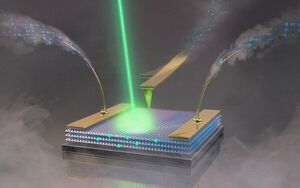
Microscopy — Beyond Moore’s Law
"Researchers at Oak Ridge National Laboratory and Korea’s Sungkyunkwan University are using advanced microscopy to nanoengineer promising materials for computing and electronics in a beyond-Moore era. Historically, computers have become faster and more powerful by Moore’s Law, an observation that technology advances as transistor sizes shrink. Today’s nanometer-scale transistors are reaching practical limits and new approaches are needed to scale existing technology. A team at ORNL’s Center for Nanophase Materials Sciences applied a focused beam of helium ions to locally tailor ferroelectricity in a metal oxide thin film, enhancing a useful property for transistors and memory. Results published in Science show how light ion microscopy can unlock unique functionalities in materials and create new pathways to design future devices. "This project highlights the advanced ion beam and scanning probe capabilities available to CNMS users, which open new frontiers to locally control and understand materials properties on the nanoscale," said ORNL's Liam Collins." [...]

Scientists at Paderborn University discover new chemical reaction
"“Finding something so novel that it might be included in textbooks as fundamental knowledge is every scientist’s dream,” says Prof. Dr. Jan Paradies, a professor at Paderborn University. Paradies, a chemist, recently discovered a previously unprecedented reaction in which an entire molecular fragment migrates to another location in the particle. “Such rearrangements are extremely rare, but they are invaluable because they only move via a very specific pathway and yield only a single product. In the future, for example, this will make it possible to simply and efficiently produce bioactive substances, such as health-promoting, beneficial ingredients in food,” explains Paradies. The results have now been published in the renowned professional journal Angewandte Chemie (“Applied Chemistry”). Chemistry deals with the transformation of matter, specifically the transformation of one molecule into another." [...]

World's First Successful Transmission of 1 Petabit per Second in a Standard Cladding Diameter Multi-core Fiber
"Wide-band wavelength division multiplexing technology significantly expands transmission capacity allowing Pb/s transmission in only 4 spatial channels Researchers from the Network Research Institute at the National Institute of Information and Communications Technology (NICT, President: TOKUDA Hideyuki, Ph.D.) report the world's first demonstration of more than 1 petabit per second in a multi-core fiber (MCF) with a standard diameter of 0.125 mm. The researchers, led by Benjamin J. Puttnam, constructed a transmission system that supports a record optical bandwidth exceeding 20 THz by exploiting wavelength division multiplexing (WDM) technology. It incorporates the commercially adopted optical fiber transmission windows known as C and L-bands and extends the transmission bandwidth to include also the recently explored S-band. Two kinds of doped fiber amplifiers along with Raman amplification with pumps added in a novel multi-core pump combiner, enabled transmission of 801 wavelength channels over the 20 THz optical bandwidth. The large number of wavelength channels were transmitted in each core of a 4-core MCF that is notable for having the same cladding diameter as a standard optical fiber. Such fibers are compatible with current cabling technologies and do not require the complex signal processing needed for unscrambling signals in multi-mode fibers, meaning conventional transceiver hardware may be used." [...]

Electrolyte Additive Offers Lithium Battery Performance Breakthrough
"Additive leads to protective surface layer for nickel-rich cathodes, improving battery performance at high voltages. A team of researchers led by chemists at the U.S. Department of Energy’s (DOE) Brookhaven National Laboratory has learned that an electrolyte additive allows stable high-voltage cycling of nickel-rich layered cathodes. Their work could lead to improvements in the energy density of lithium batteries that power electric vehicles. The findings, published on May 9 in Nature Energy, offer a remedy to notorious degradation problems that crop up for nickel-rich cathode materials, especially at high voltages. This research was conducted as part of the DOE-sponsored Battery500 Consortium, which is led by DOE’s Pacific Northwest National Laboratory (PNNL) and is working to significantly increase the energy density of lithium batteries for electric vehicles. Sha Tan, a co-first author and Ph.D. candidate at Stony Brook University conducting research with the Electrochemical Energy Storage group at Brookhaven Lab, was originally studying how an additive, lithium difluorophosphate (LiPO2F2), could be used to improve low-temperature performance of batteries." [...]

Discovery of new mechanisms to control the flow of sound
"Using a network of vibrating nano-strings controlled with light, researchers from AMOLF have made sound waves move in a specific irreversible direction and attenuated or amplified the waves in a controlled manner for the first time. This gives rise to a lasing effect for sound. To their surprise, they discovered new mechanisms, so-called ‘geometric phases’, with which they can manipulate and transmit sound in systems where that was thought to be impossible. “This opens the way to new types of (meta)materials with properties that we do not yet know from existing materials,” says group leader Ewold Verhagen who, together with shared first authors Javier del Pino and Jesse Slim, publishes the surprising results on June 2 in Nature. The response of electrons and other charged particles to magnetic fields leads to many unique phenomena in materials. “For a long time, we have wanted to know whether an effect similar to a magnetic field on electrons could be achieved on sound, which has no charge,” says Verhagen." [...]
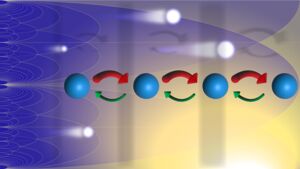
A new duality discovered at Purdue University solves a physics mystery
"In conventional wisdom, producing a curved space requires distortions, such as bending or stretching a flat space. A team of researchers at Purdue University have discovered a new method to create curved spaces that also solves a mystery in physics. Without any physical distortions of physical systems, the team has designed a scheme using non-Hermiticity, which exists in any systems coupled to environments, to create a hyperbolic surface and a variety of other prototypical curved spaces. “Our work may revolutionize the general public’s understanding of curvatures and distance,” says Qi Zhou, Professor of Physics and Astronomy. “It has also answered long-standing questions in non-Hermitian quantum mechanics by bridging non-Hermitian physics and curved spaces. These two subjects were assumed to be completely disconnected." [...]
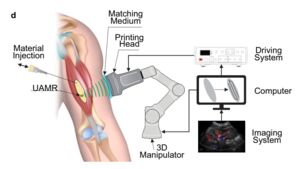
Direct sound printing is a potential game-changer in 3D printing, according to Concordia researchers
"The new platform technology uses ultrasound waves to create complex and precise objects Most 3D printing methods currently in use rely either on photo (light)- or thermo (heat)-activated reactions to achieve precise manipulation of polymers. The development of a new platform technology called direct sound printing (DSP), which uses soundwaves to produce new objects, may offer a third option. The process is described in a paper published in Nature Communications. It shows how focused ultrasound waves can be used to create sonochemical reactions in minuscule cavitation regions — essentially tiny bubbles. Extremes of temperature and pressure lasting trillionths of a second can generate pre-designed complex geometries that cannot be made with existing techniques. “Ultrasonic frequencies are already being used in destructive procedures like laser ablation of tissues and tumours." [...]
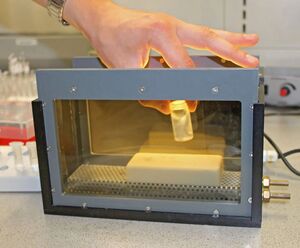
Bayreuth researchers develop new method for the technological use of 2D nanomaterials
"Nanosheets are finely structured two-dimensional materials and have great potential for innovation. They are fixed on top of each other in layered crystals, and must first be separated from each other so that they can be used, for example, to filter gas mixtures or for efficient gas barriers. A research team at the University of Bayreuth has now developed a gentle, environmentally-friendly process for this difficult process of delamination that can even be used on an industrial scale. This is the first time that a crystal from the technologically attractive group of zeolites has been made usable for a broad field of potential applications. The delamination process developed in Bayreuth under the direction of Prof. Dr. Josef Breu is characterised by the fact that the structures of the nanosheets isolated from each other remain undamaged. It also has the advantage that it can be used at normal room temperature." [...]
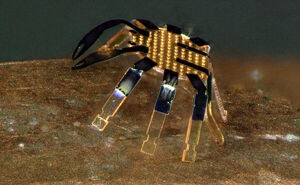
Tiny robotic crab is smallest-ever remote-controlled walking robot
"Smaller than a flea, robot can walk, bend, twist, turn and jump Northwestern University engineers have developed the smallest-ever remote-controlled walking robot — and it comes in the form of a tiny, adorable peekytoe crab. Just a half-millimeter wide, the tiny crabs can bend, twist, crawl, walk, turn and even jump. The researchers also developed millimeter-sized robots resembling inchworms, crickets and beetles. Although the research is exploratory at this point, the researchers believe their technology might bring the field closer to realizing micro-sized robots that can perform practical tasks inside tightly confined spaces. The research was published today (May 25) in the journal Science Robotics. Last September, the same team introduced a winged microchip that was the smallest-ever human-made flying structure (published on the cover of Nature)." [...]
Projetos Maker
Diversos Projetos interessantes.
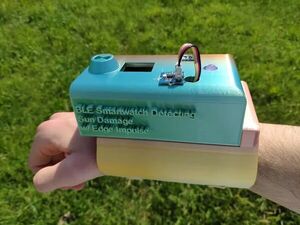
BLE AI-driven Smartwatch Detecting Potential Sun Damage
"Log UV & weather data on an SD card to train an Edge Impulse model. Then, run it to get informed of sun damage over BLE via an Android app. Although many of us enjoy a sunny day in our leisure time, the glaring sun can affect our health detrimentally, especially for the elderly, children, and people with light skin. Excess sun exposure can cause minor health conditions such as sunburn, dehydration, hyponatremia, heatstroke, etc. In more severe cases, excess sun exposure can engender photoaging, DNA damage, skin cancer, immunosuppression, and eye damage, such as cataracts[1]. Therefore, it is crucial to detect sun damage risk levels so as to get prescient warnings regarding potential health risks to mitigate the brunt of inadvertent excess sun exposure." [...]

Automated Bike Turning Light!
"An automated turning detection and display system for bikes. Using this, we won The Conrad Challenge CYBER-TECH& SECURITY Silver Medal In daily life, bicycles are a common means of transportation for people. Since bicycles do not have Turning Lights often found in motor vehicles, it is difficult to inform nearby pedestrian vehicles when turning and changing travel speed, so traffic accidents can easily occur in such situations. As an avid cylist myself, I designed a bicycle steering alert system is developed for the scenario of bicycle steering. The device is mainly controlled by Arduino, and with the help of Bluetooth wireless transmission technology, the steering and auxiliary data collected by the upper computer, such as steering instructions, speed and driving intentions, are sent to the lower computer for processing. The steering information is then displayed on a high-powered LED digital dot matrix screen, and the steering information is prompted by a voice announcement device." [...]

IoT & Home Automation w/nRF24l01 & Raspberry Pi
"How to setup IoT devices with Arduino and a Raspberry Pi for a home automation system. Overview I've developed a communication stack based on the OSI model for nRF24 radios over the past number of years, and it is fairly complete and fully functional. It supports quite a wide range of communication scenarios, with a mesh layer that allows wireless nodes to find communication paths through the network automatically when a given connection fails or goes offline and uses other nodes to bridge the distance between points in the network. This is one of the more advanced scenarios on how to use it. Basically what I am doing is using the internet connected Raspberry Pi as a gateway for all of my Arduino devices, which will run their own IP stack and communicate directly with the Raspberry Pi using the MQTT protocol. This allows me to send and receive information to and from the Arduinos using any device/software that supports MQTT, including mobile devices." [...]

DIY dosimeter for the youngest engineers
"The purpose of the article is to create the most detailed assembly instructions how to make your first do-it-yourself radiation detector Introduction to DIY dosimeter I bet that you have ever thought about buying a personal dosimeter to measure the level of radiation at home, while walking or traveling. Today we will assemble a simple cheap dosimeter based on the ESP32 WiFi-controller and the RadSens board. RadSens is a ready-made I2C module for a gas-discharge Geiger-Muller counter. A reliable and widespread SBM20-1 tube will be used as a sensor. However, instead of it, any other tube can be connected to the module - J305, M4011, STS-5, etc. The purpose of the article is to create the most detailed assembly instructions." [...]
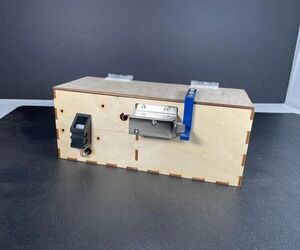
DIY Fingerprint Lock Box
"Ever wanted a box that opens in a super cool way? We thought it would be fun to create a box that can be unlocked using the correct fingerprint! If we had more time, we would make the box more secure. In the mean time, we have learned a lot and had a lot of fun. We found several tutorials online that inspired us to make this awesome project: How to Set Up Fingerprint Sensor With Arduino Techatronic Arduino fingerprint security lock DIY Fingerprint Door lock System Although this project is recommended for the beginner to intermediate level, we personally found several parts of it very challenging, and hope this Instructable will help others have an easier time than we did. Materials: - Arduino UNO - Fingerprint Sensor (from Adafruit) - Solenoid Lock - Jumper Cables - One Channel Relay Module - Breadboard - Rechargeable 12V Lithium Ion Battery Pack - Male-to-male DC power cable - 2 Hinges - 4 M3x8 screws - 2-10 M3x12 screws - Arduino USB cable - DC Power Jack Plug Adapter Tools: - Wood glue - Adobe Illustrator/SVG editing software (Optional) - Arduino IDE - Soldering iron and solder - Laser Cutter (Optional) - Wire Cutters - Wire Strippers - Dial/Digital Calipers - CAD Software - 3D printer - Screwdriver (for relay module and other electric components)" [...]

Air Quality Monitoring ESP32-Based System
"The system will be an ESP32 NodeMCU-based Air Quality monitoring system for checking PM, particulate matter (PM) as well as humidity... Air Quality Monitoring ESP32-Based System The system will be an ESP32 NodeMCU-based Air Quality monitoring system for checking PM, particulate matter (PM) as well as humidity as well as temperature, altitude as well as pressure. The various aspects of the environment of the location are tested and then displayed on the TFT screen and also using the ThingSpeak IoT (Internet of Things) platform. The prototype developed by the author is shown in Fig. 1. Particulate matter Dust and PM pose a health risk. PM2.5 can be smaller than 2.5 microns in diameter as is PM10 lower than 10 microns wide." [...]
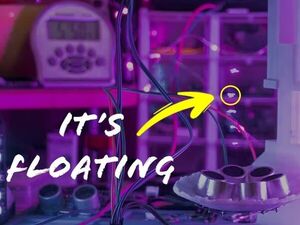
How To Make Ultrasonic Levitator with Arduino
"In this tutorial, I will teach you how to Levitate objects using sound waves and of course with the help of an Arduino board. Ultrasonic Transmitter If you have ever worked with ultrasonic modules, for example, SRF05, you have noticed that two ultrasonic sensors are used in this group of modules, one to send waves and the other to receive that using the same wave travels back and forth projects easily. Sensors are made, if you disassemble these sensors, two letters R or T are printed on the back of these sensors. We need a T or Transmitter to make this project. The R Type is the receivers. L298N Driver Module The L298N driver module is normally used to start DC motors, but as you will see later in this project we will use this module differently." [...]
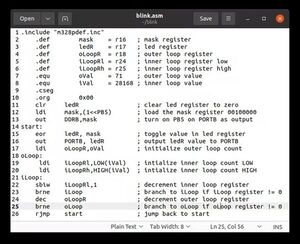
Explore AVR assembly language
"Let's learn about the AVR microcontroller and the assembly language. We create an assembly program to blink the LED on an Arduino Uno board. Assember programming is hardware level, we use a simple set of commands to perform mathematics and move bits around. At this level we turn circuits on and off with our commands. Avrasm2 is the program from Atmel (now MicroChip) for their AVR products. You install it on Windows computers when you setup MicroChip Studio IDE or an older Atmel Studio Suite." [...]

Clock with SH1106 OLED display & DS1302 RTC module
"A short, simple project about a clock made with an Organic LED display and DS1302 RTC clock module, for ex. to use in full-screen game... Supplies: - Arduino UNO board clone (you can use the original one, I'mtoopoor). - DS1302 RTC clock module (Waveshare 9709) - A button (it can be any button bro) - 1, 3" OLED screen (SH1106 driver) - 830-pin breadboard - Connection cables" [...]
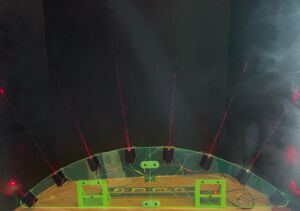
MIDI Laser Harp with Time of Flight Distance Sensors
"A laser harp is an electronic instrument that lets you "pluck" laser beams like a harp to play notes. In this guide, you'll learn how to build your own version of a laser harp using a Feather M4 Express or Feather RP2040, a Music Maker FeatherWing and code written in CircuitPython. VL53L4CD time of flight sensors are used to detect when you're playing a note instead of simply detecting the break-beam. This means we can do cool stuff like use the distance data from the time of flight sensors to convert into different MIDI values such as modulation, sustain and velocity. We use a Music Maker wing which has audio output from MIDI input and a wide variety of musical instruments it can generate sound effects for, see page 32 of the VS1053 datasheet for a full list! Of course you can also generate MIDI-over-USB signals that can be used to control your favorite software synth." [...]
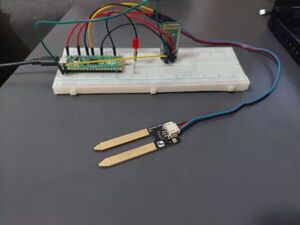
Soil moisture sensor with message notification
"This project comes in handy for people that love gardening. The idea is simple, monitoring the soil humidity and notifying the Gardner. This project is a great help for people who are passionate about gardening and flowers. Its purpose is to monitor and notify the owner when the humidity has dropped below a certain level and the plant needs water, or if the sensor detects a high level of humidity to alert someone to turn off the irrigation system. The user is notified by a message sent to the phone. There are already many such products on the market that have included similar devices." [...]
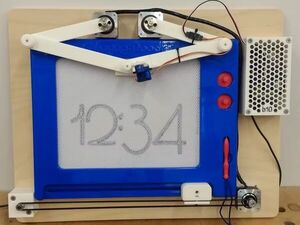
Magna Doodle Clock
"Draw the current time on a Magna Doodle using your favorite TrueType fonts I have a thing for clocks. This is my 4th clock design (and the only one that works at the moment, lol). I wanted to do something similar to my Etch a Sketch and thought a clock made from a Magna Doodle would be fun. A quick search found these existing projects online: RoboClock, DoodleClock, and the famous PlotClock. But, as usual, I wanted to try making my own version. " [...]

PewPew LCD
"Learn Python programming with an affordable gaming handheld. Learn Python programming with an affordable gaming handheld. Teaching programming is hard. And it's not made any easier by the fact that before you even start teaching, you have to first do the ungrateful job of an IT support worker and get your students through all the hoops of installing all the necessary software and libraries on their computers. And when you finish, the programs they have written only works on their own computers, unless they go through all the same (and possibly some additional) hoops. The PewPew family of devices is one possible answer to this." [...]

CUBOTino Autonomous: Small, 3D Printed, Rubik's Cube Robot (Raspberry Pi Zero 2, PiCamera)
"This is the "Top version" of CUBOTino series, a Rubik's solver robot project meant to be very small, simple, fully 3D printed, and scalable. This is clearly not a fast robot, as the targets are simplicity and cost effectiveness. The "Base version", characterized by lower costs and lower complexity, is already available at: https://www.instructables.com/CUBOTino-a-Small-Simple-3D-Printed-Inexpensive-Rub/ This instruction relates to the Top version; main characteristics are The robot is fully autonomous. PiCamera and Raspberry pi Zero 2 are used for the computer vision part. Kociemba solver is used, to get an almost optimal solution. All coded in Python." [...]
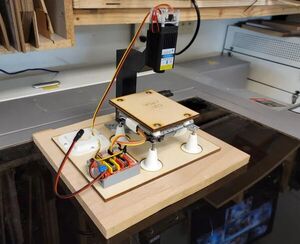
Laser Engraver Made With Repurposed CD/DVD Computer Drives
"Over half a year ago now, while trying to think up ideas for a project, I found a tutorial for a pen plotter that used the stepper motor mechanisms contained within DVD and or CD computer drives to create a CNC platform. These drives became a very common scrap part after disk drives went the way of the dinosaur in PCs, so I was sure I could find some to use for this project. Unfortunately for me, the instructions proved to be inadequate in many ways, with vital information missing, confusing grammar, and significant portions of the project being explained vaguely or not at all, simply appearing in the next step without reason. These issues frustrated me, and while I could have spent the time to fill in the blanks myself, I found that I could, and wanted to, make my own project. Along the way, the pen plotter turned into a laser engraver and with that came many other alterations that I designed, prototyped, and implemented myself. It is because of this that I can call this project my own, and I hope that you will follow along as I show you how to build one for yourself." [...]

Advanced Water Management (AWM) in 10 Steps
"If 100 people lived on Earth, 74 had drinking water available when needed and free of contamination. (source: who). With this instructable, slightly more. The equipment presented here permanently monitors and controls the water supply for a community of 7 houses. Hang around, I'll explain everything. For five decades a small community in eastern Europe, in northern Romania, is dependent on a natural uphill spring water source; since the harmony with nature is declining ever since, a second source of water has been found - a well, which however requires an additional pump that fills the main supply tank." [...]

DIY Wheatstone Bridge
"A Wheatstone bridge is an electrical circuit used to measure an unknown electrical resistance by balancing two legs of a bridge circuit, one leg of which includes the unknown component. The primary benefit of the circuit is its ability to provide extremely accurate measurements (in contrast with something like a simple voltage divider). Its operation is similar to the original potentiometer. The Wheatstone bridge circuit mainly consists of two known resistors, one variable resistor, one unknown resistor (whose value to be calculated) and a Galvanometer (detect and measure small amounts of current in an electrical circuit). In the place of the resistors and galvanometer I have used small bulbs which I got from old decorative lighting strip. The resistance of all the bulbs are same." [...]
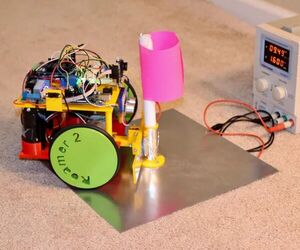
Pet Robot
"I always wanted a pet robot--one that runs around and takes care of itself. Roamer 2 wanders about, detecting objects using sonar and her front bumper. She mostly stays out of trouble. Her maximum run time is about 11 minutes, but she starts hunting her charger (using a Pixy camera and Arduino) after 4 minutes. Charge time is around two minutes. Because she is powered by super capacitors, she can charge and discharge tens of thousands of times (at most any rate) without degradation of the capacitors." [...]

Raspberry Pi Pico - Alarm Clock
"Hello everyone, do you have a Raspberry Pi Pico and want to build an alarm clock and need some guidance on getting started? If so, this instructable is for you. This project is a straightforward alarm clock based on the Raspberry Pi Pico. The clock displays the time and date on the popular 16x2 character LCD and has an easy interface to set the alarm. The clock has a very simple interface through 4 push buttons. This is an excellent project for anyone getting started with the Raspberry Pi Pico, as you will learn the basics of MicroPython and use standard popular modules." [...]

Nanoleaf 2.0
"Hey What's up you guys! So this is the Nanoleaf 2.0 which is a DIY version of the famous Nanoleaf RGB Triangular lighting setup. The goal here was to Recreate a Nanoleaf-like device with minimal spec and low cost, one that has all the basic RGB Glowing features and can be made easily. To accomplish this feat, I prepared this setup completely from PCBs that were provided by PCBWAY. This Instructables is gonna be about the whole built process of this economic version of Nanoleaf so let's get started! Following were things required to make this project- Custom PCBs WS2812B LEDs Attiny85 SOIC8 SMD Button USB Micro Port vertical 100nf Cap 5V Power Source Arduino Nano (for flashing Attiny85)" [...]
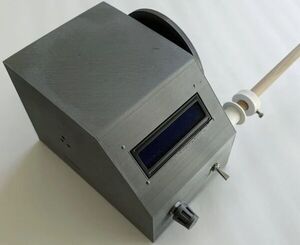
DIY Pickup Winder
"HHello there, Thank you for stopping by. Today I am going to show you how I built a pickup winder to wind pickups for electric guitars and basses. I don’t play guitar but I did take some bass lesson in high school, I remember nothing but several riffs for Red Hot Chilli Pepper songs, I had an interesting teacher… I don’t play any more. A friend asked if I could build one ask I decided to make one for them and show all of you how I did it as well. The goal was $50 US, I got pretty close but did end up going over. This does assume you have or have access to a 3D printer." [...]
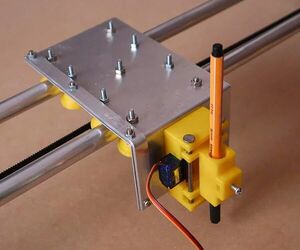
CNC Pen Lift
"This instructable explains how to make a CNC pen-lift from an SG90 servo, two 4mm x 100mm nails, the spring from a ball-point pen, and a 3D printer. The design accommodates pen diameters up to 14mm. There is no pen-wobble when the pen is raised and lowered. Construction is easy … all you need is access to a 3D printer, and basic workshop tools. All STL and gcode files are supplied. The estimated cost to build this pen-lift is less than $5.00 USD Supplies: The SG90 servo, complete with horn and mounting screws, was obtained from https://www.aliexpress.com/ The following items were obtained locally 1 only M4 x 20mm bolt 1 only M4 nut 1 only ball-point pen spring 2 only 4mm x 100mm flathead nails The yellow items were printed on a Voxelab Aquila 3D printer using 1.75mm diameter filament and a 0.2mm nozzle." [...]
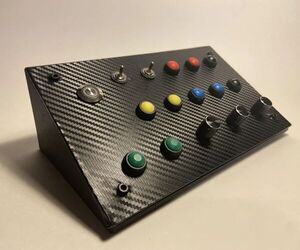
How to Design a Button Box Housing With Schematic and PCB
"A couple months ago, I started a project on Tinker CAD, this would later become my fully working Button Box that I now regularly use in sim games and even for shortcuts in Fusion360. Up to my Tinker CAD project, I had limited skills in CAD and electrical design. After some time researching, I consider myself abled in both CAD design and electrical design (By no-means am I a professional so please take this advice with a grain of salt and feel free to let me know of any errors or improvements). For this Instructable, I will betrying to teach you the skills to design your own Button Box, as opposed to a set-in-stone final product, so my final product may look a little different than my examples. For this Instructable, I recommend some exposure to Fusion360 or CAD software as I do not go in-depth on the basics of CAD. Some skills you can expect to learn in this Instructable are: How to utilize Parameters in Fusion360 to create your Button Box Housing How to create your own schematic for your own button box How to utilize your own schematic to create a schematic in Fusion360 Howto create your own electrical library for your schematic in Fusion360 How to transform a schematic in Fusion360 to a PCB How to Auto-Route nets for your PCB Unfortunately, I will not be teaching you to code your button box, as I do not yet feel comfortable in sharing code that I've designed." [...]

Cornstarch Pottery Machine
"Cornstarch mini pottery machine, and built with an old printer and cd-player My idea was born from the experience of seeing and buying samples of miniature pottery made of clay. Some time later, I had the concern to learn to work this art but with recycled material and I found that in my country it is popular to do it with corn starch only that certain rules had to be followed to obtain a good quality mixture. Finally, I am exploring this project that continually undergoes changes because I am experiencing many things that I share with you in this work. This is a machine that I use to work miniature pottery made mainly with cornstarch. This is a sustainable idea that respects nature and promotes the circular economy This is a project focused on sustainability, and in its first version I faced the challenges shown below: - Reuse and modify an old printer to place and organize the components and supplies for this project; - Reuse an old cd-payer motor to work and experiment with miniature pottery; - Recycle organic matter such as cornstarch to create miniature pottery. To achieve this goal, I have experimented and found the amount of material necessary to obtain a good job, that is, of good quality and resistance; and - This work promotes the circular economy, since it proposes a completely different approach that allows stimulating economic growth and generating self-employment without compromising the environment." [...]
Secção Videos
Videos interessantes.
That's all Folks!




